Enjoy the rich, velvety taste of a brownie in macaron form. This brownie buttercream filling is for all chocolate lovers who want a little indulgence in their lives.

Want To Save This Article?
Enter your email below and we'll send it straight to your inbox. Plus, you'll receive new weekly recipe inspiration.
Brownies are one of my all-time favorite desserts! So it's no wonder that I wanted to turn this classic dessert into a flavorful chocolate macaron filling.
These brownie macarons are made with chocolate macaron shells. Then, sandwich a rich, fudge-like brownie buttercream in between.
Whether you're an expert macaron baker or just starting, this recipe will walk you step by step through everything you need to know. Plus, if you're running into any issues along the way, check out the FAQs below.
Don't forget, you can leave a comment below and I'll help you out!
Jump to:
What You'll Learn In This Recipe
- How to make beautiful macaron shells with a fudgy chocolate brownie filling.
- The most important steps to get correct in order to bake perfect macarons.
- Troubleshooting steps to try if your macarons aren't turning out correctly.
Enjoy learning tips about making chocolate macaron shells? Sign up for my free macaron template and email series. You'll learn my favorite tricks for achieving perfect macarons.
Ingredients You Need
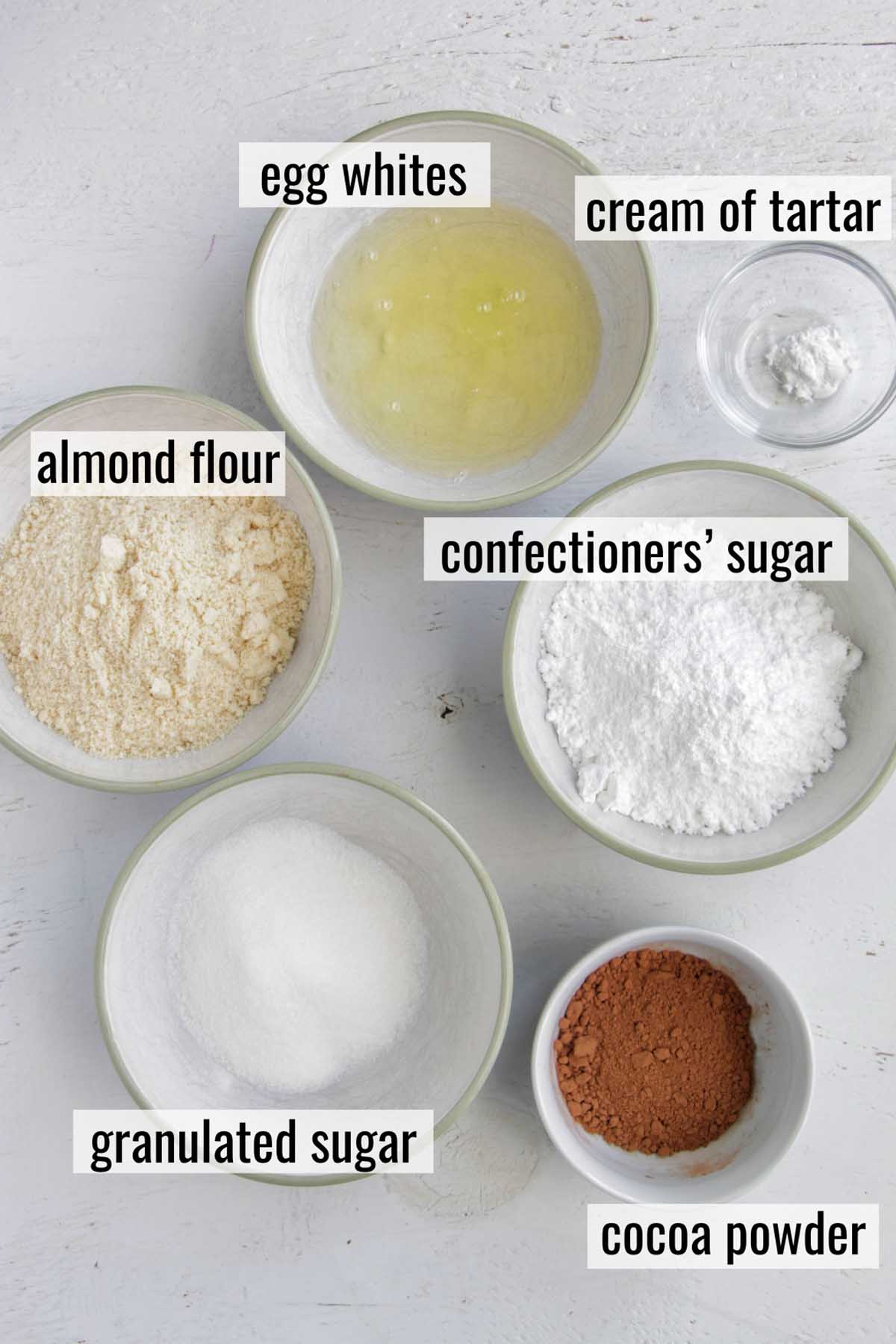
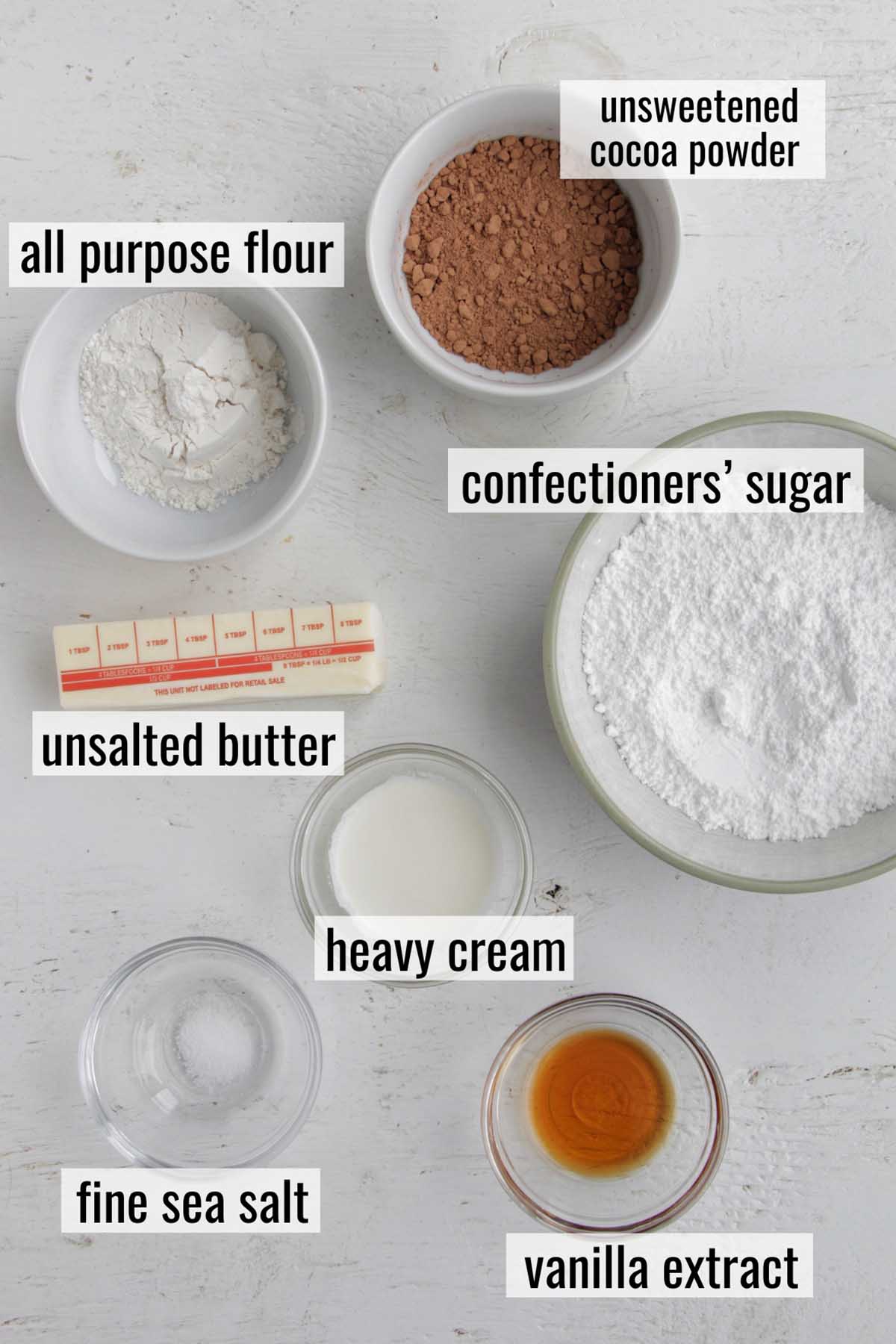
Confectioners' sugar: An essential element in macarons, confectioners' sugar (also called powdered sugar or icing sugar) plays a crucial role in determining the size of the macaron feet, contributes to softening the macaron shell, and enhances overall texture.
Super fine almond flour: Crafted from finely ground almonds, this ingredient introduces a subtle yet delightful flavor to macarons. To ensure a smooth texture, it is imperative to sift the almond flour, eliminating any large clumps. My preferred brand is Blue Diamond Almond Flour.
Egg whites: Serving as the foundation for the meringue, egg whites undergo a transformation as air is incorporated, causing certain egg proteins to unfold. These unfolded proteins create a robust network of air bubbles, providing a solid base for the macarons.
Cream of tartar: The addition of this acidic substance to the meringue aids in stabilizing the egg whites. Incorporating cream of tartar results in a sturdier and more consistently textured meringue. Although it's possible to create macarons without cream of tartar, this ingredient significantly helps the structural integrity and consistency of the final product.
Granulated sugar: With French macarons, granulated sugar is directly incorporated into the whipped egg whites. This addition plays a vital role in fortifying the meringue's structure. Insufficient granulated sugar may lead to an excessively airy meringue, while an excess may result in a thick and glossy consistency. Striking the right balance is key to achieving perfect French macarons.
How To Make This Recipe
Let's break down how to make brownie macaron shells and fillings.
1. Prep Work

Before you embark on the macaron baking journey, it's crucial to complete some preliminary tasks to lay the groundwork for a successful outcome:
- Separate the egg whites from the yolks and allow the egg whites to reach room temperature, as they foam best in the range of 70°F (21°C) - 80°F (26°C).
- Use a digital kitchen scale to accurately measure all dry ingredients, ensuring precision in the ingredient quantities.
- Combine and sift the almond flour, confectioners' sugar, and cocoa powder to eliminate any notable clumps. Discard any larger almond flour pieces that could result in uneven shell textures.
- Thoroughly clean the stand mixer bowl and whisk attachment by wiping them with a paper towel dampened with white vinegar. This step eliminates any lingering oils, as fats can impede the proper aeration of the egg whites, potentially compromising the meringue.
- Print a macaron template and position it on a light-colored sheet pan beneath a sheet of parchment paper.
- Prepare your piping bag with a ½ inch (1.27 cm) round tip, ensuring a secure fit by pushing part of the side of the piping bag into the piping tip. Place the bag inside a tall glass, with the remaining top of the piping bag pulled out over the outside of the glass for easy and neat batter pouring.
2. Make The French Meringue

Now, it's time to make a French style meringue. This is a major component of the macarons, so it's important to get this step correct.
Add the room temperature eggs and cream of tartar to a stand mixer fitted with a whisk attachment.
Whip on medium-low speed (I use speed 4 on my KitchenAid mixer) until the eggs are very foamy. This usually takes about 3 - 4 minutes.
Once the eggs are very foamy and you see small bubbles all around the mixer, it's time to slowly begin adding in the granulated sugar. Keep the mixer on a medium-low speed, and add in a third of the granulated sugar.
Allow the mixer to beat in each batch of sugar for about 45 seconds before adding in another batch.
This allows the sugar crystals time to dissolve so they don't weigh down the egg whites. If the sugar is added too quickly, it can affect the final structure, resulting in an under whipped and weak meringue.
Once all the granulated sugar is incorporated, turn the mixer speed to medium-high (I use speed 7 on my KitchenAid mixer), and allow the egg whites to continue to whip until stiff peaks form, around 10 - 11 minutes.

If you're new to baking macarons, I'd suggest setting a timer. This will keep you aware of how long the meringue has been whipping.
This is a very crucial step to get correct. If your meringue is under whipped, you're likely to have problems once the shells bake up.
Here are some visual cues to look for to ensure your meringue has whipped to stiff peaks:
- You'll notice the meringue starts to ball up inside the whisk while it's mixing.
- Pull the whisk out of the mixer. A stiff peak should stand straight up (no curl at the tip).
- You can see pointy off-shoots of egg whites on the whisk when you pull it out of the mixer.
- You can fully flip the bowl over and nothing moves or falls out.
- The meringue feels sturdy (not flimsy).
- The egg whites hold the indentation that the whisk makes as it's whipping.
Generally, if you're new to baking macarons, you're likely to under whip the meringue. Don't be afraid to whip a little longer if you're not seeing all of these visual cues.
3. Macaronage The Batter
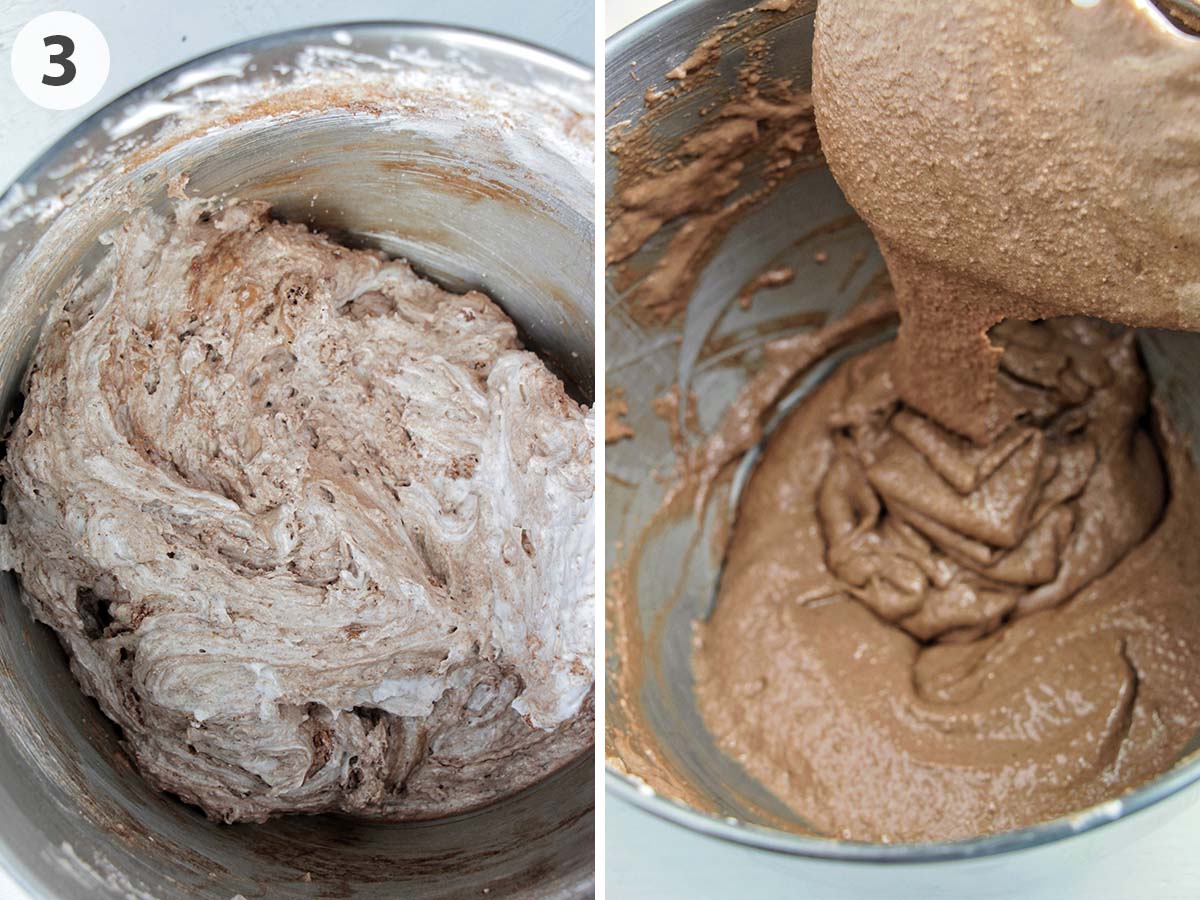
Grab a heavy-duty silicone spatula, and fold the sifted almond flour, confectioners' sugar, and cocoa powder into the meringue. Continue until all the meringue is fully incorporated and no dry bits of almond flour remain on the bottom of the bowl.
Next, it's time to macaronage the batter. This is another important step to correctly perform.
Macaronage is a term that refers to folding the dry macaron ingredients (almond flour, confectioners' sugar, and cocoa powder) into the meringue. This process smooths the mixture and helps the macarons bake with proper structure.
To properly macaronage, you will continue folding the batter until it reaches a lava-like consistency. The goal of macaronaging is to deflate some of the air that was incorporated into the meringue.
You can test that you've achieved the perfect consistency by lifting your spatula and seeing if the batter drops almost like lava. The batter should still have a thick consistency to it. Once it drops off the spatula, the batter that was dripped should fade back into the batter within 10 - 15 seconds (not immediately).
Additionally, the almond flour should look blended into the meringue (not lumpy).
Many home bakers who are new to baking macarons will over macaronage the batter, meaning that the batter will be too runny.
If you're unsure if your batter has been properly macaronaged, it's better to under macaronage a bit since the batter will still be worked in the piping bag.
4. Pipe The Macaron Shells

Pour the batter into the prepared piping bag. Hold the bag vertically, and gently pipe 1.5 inch circles. Once you have reached the desired size, release the pressure on the bag and twist your wrist without lifting up.
Elevate your piping technique with these helpful tips:
- Ensure a steady hand movement while piping to create consistently shaped circles.
- Consider slight spreading during baking; pipe macarons about 0.25" smaller than your desired end size.
- Give a gentle flick of the wrist after piping the desired size to achieve a neat and refined finish on each macaron.
Tap the sheet pan down on the counter a few times to release any air bubbles. You can tap the pan fairly aggressively, so don't be scared! Failure to do this could result in cracked macarons.
Once you've tapped the sheet pan, you may notice some large air bubbles that have formed. To help improve the texture and appearance of the macaron tops, pop any large air bubbles that rise to the top with a toothpick.
Next, it's time to allow the macarons to dry. Before baking the macarons, allow the batter to sit on the counter and dry for 45 - 60+ minutes until a thin "skin" develops, and you can touch the tops without ruining the macaron. This may take up to 90+ minutes if you live in a humid climate, or it's a rainy day.
If you're having trouble with this, check out my tips for how to fix macarons that aren't drying.
5. Bake Macarons

While the macarons are drying, heat your oven to 300°F (150°C). If this is your first time making macarons, you might want to experiment with the oven temperature to find out the best temperature range for your home oven.
Once the macarons are done drying, bake one sheet at a time on the center rack of the oven for 24 - 27 minutes. I've found that chocolate macarons take slightly longer to bake. So, allow them to stay in the oven for about 5 minutes longer than your normal batch of macarons without cocoa powder.
Check that the macarons have fully baked using the following tests:
- The feet and the edge of the macarons feel firm when you gently touch them.
- It feels like you could forcibly lift the macaron shell off the parchment paper if you needed to (don't actually do this, just use it as a test).
- If you touch the shell and it wiggles, is still sticky, or is wet, you know the macarons need longer to bake.
6. Make The Filling
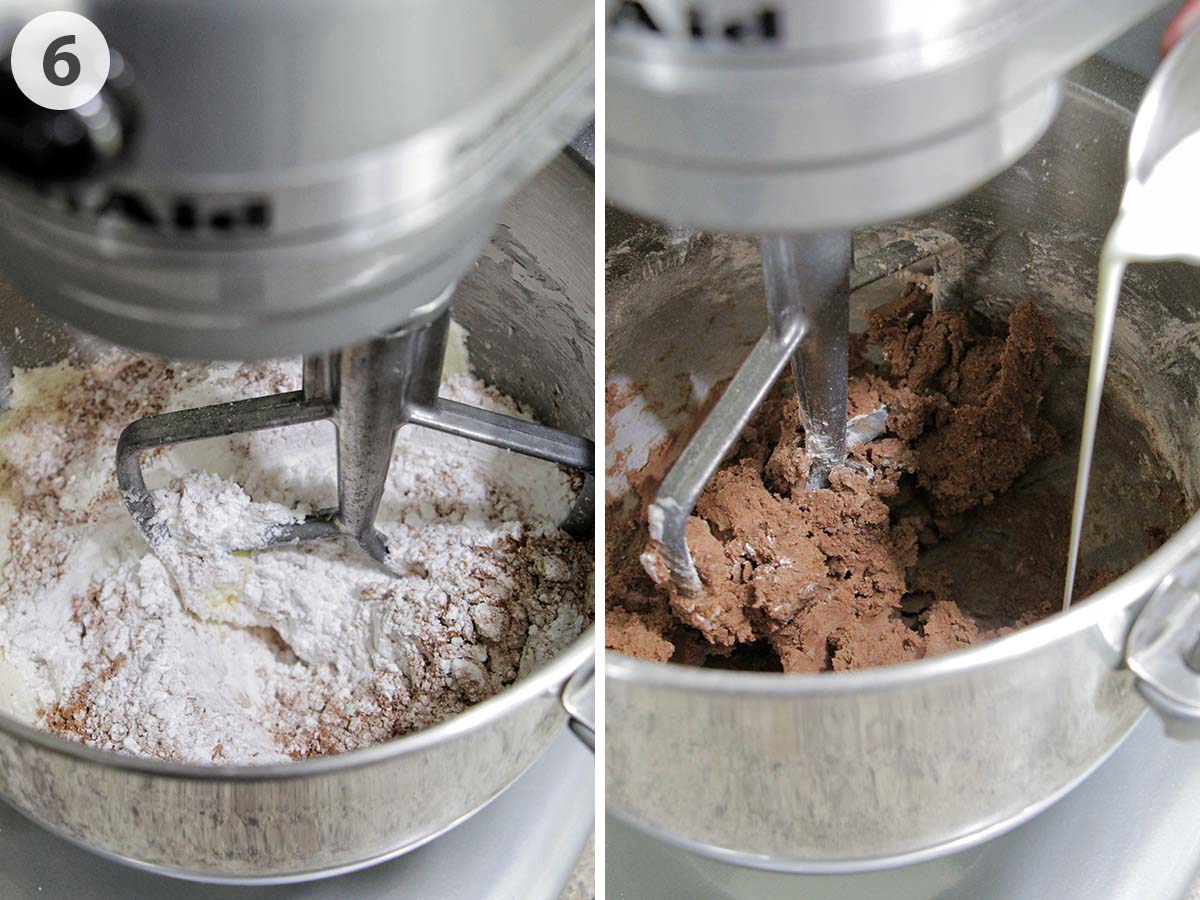
Heat oven to 350°F (175°C). Spread flour into a thin layer on a baking sheet lined with parchment paper. Bake flour for 3 - 5 minutes until the flour reaches 160°F (72°C) on a digital thermometer. Set the flour aside and allow it to fully cool.
Beat butter in a stand mixer fitted with a paddle attachment on medium-high speed until light and fluffy, about 2 - 3 minutes. Scrape down the sides of the mixer as needed.
Add flour, confectioners' sugar, and cocoa powder; mix on medium-low speed until combined.
Add heavy cream, vanilla extract, and fine sea salt; mix until fully combined.
Set the mixer to medium-high speed, and allow the buttercream to beat for an additional 5 minutes. The filling will still be slightly thick.
7. Fill Macarons
After the macarons have cooled completely, proceed to pipe the filling.
Match up macaron shells, so they are paired with a similar size/shaped shell. Pipe the buttercream filling on one side of the macaron shell using a round piping tip. Gently place the matching macaron on top of the filling.
Finally, refrigerate the macarons with the filling overnight for maturation. This step helps the macarons achieve a subtle softening and enhances the flavor profile.
Expert Tips
- If you choose to use salted butter instead of unsalted butter for the filling, be sure to adjust the amount of added salt to taste.
- Substitute unsweetened cocoa powder for a Dutch-processed cocoa powder if you prefer a stronger, richer tasting brownie buttercream filling.
- If the buttercream is too warm when serving the macarons, the filling will push out the sides of the shell when you bite into it. Serve the macarons shortly after pulling them out of the refrigerator from maturing, once they reach room temperature.
- If you live in a warm environment, the buttercream may become thin during the whipping process. Allow the buttercream to chill slightly in the refrigerator before piping.
- Want to make the brownie filling ahead of time? As long as the heavy cream is fresh, it can be made up 3 weeks ahead of time.
Recipe FAQs
Store filled brownie macarons for up to 7 days in an airtight container in the refrigerator.
Here are a few common causes of flat macarons:
1. The oven is too hot or too cold: If your oven is too low, you'll notice that the macarons won't properly rise. Not only will they be flatter than a normal macaron, but the feet will be short (under 2 millimeters), and the tops will likely be wrinkly or indented.
On the other hand, if your oven is too hot, the shells will be flat because proper feet will not form. The macarons will bake too quickly on the outside, leaving a moist interior that doesn't properly rise.
2. You under whipped the meringue: You didn't whip your meringue to stiff peaks. Under whipped meringue won't be strong enough to properly rise in the oven. It can lead to flat, wrinkled, or weak macaron tops.
3. You over macaronaged your batter: Another common issue that results in flat macarons is over macaronaged batter. Macaronage is a term that refers to folding the dry macaron ingredients (almond flour and confectioners' sugar) into the meringue. This process smooths the mixture and helps the macarons bake with proper structure.
When you over macaronage, you'll notice the batter is very thin and easily falls off the spatula. You'll also notice that the batter spreads really easily when piped. It might even fall out of your piping bag when transferring from one circle to the next on your piping template.
If you're still having trouble, check out my troubleshooting guide for flat macarons.
Here are a few common causes of cracked macarons:
1. Your oven is too hot: Most likely, cracked macarons are related to oven temperatures that are too hot. To fix this issue, you'll first want to purchase an oven thermometer.
This inexpensive cooking tool will allow you to see if your oven is heating to the temperature you're setting it to. Oftentimes, home ovens are known for heating hotter or colder than you set the temperature to.
2. Your meringue is under or over whipped: Both under-whipped and over-whipped meringue can result in cracked shells. This is because the meringue needs to have the proper structure in order to rise in the oven.
Weak meringue will not be strong enough to withstand the heat of the oven when baked, causing a cracked top. Alternatively, meringue that has been over-whipped won't have enough air incorporated to properly expand in the oven.
3. You didn't rest your macarons long enough: It's important to allow your macarons to rest on the counter until they've formed a skin.
Typically, you'll need to allow the shells to rest for about 45 - 60+ minutes on the counter until a skin has formed on top. If you live in a humid climate, this may take up to 90+ minutes.
4. You have air bubbles in the macarons: Did you put your macarons in the oven without banging them on the counter? Oftentimes, air bubbles are trapped in the macaron batter. Air bubbles occur naturally in the batter during the macaronage and piping process.
In order to avoid cracked macaron shells, you need to release and pop these air bubbles, otherwise, they will burst in the oven and ruin the shells.
If you're still having trouble, check out my troubleshooting guide for cracked macarons.
Here are a few common causes of wrinkled macaron shells:
1. You used too much cocoa powder: Using too much cocoa powder can cause your macarons to bake up wrinkled. Even 10 grams more can have a huge impact on the macaron shells. Be sure to follow the specific measurements listed in the recipe card below.
2. Your oven temperature is too low: To remedy this, you'll first need to purchase an oven thermometer, and place it in the center rack of your oven to double-check the temperature reading before baking the macarons.
Next, you'll need to play around with your temperature settings. I usually recommend heating your oven to 300°F (150°C) and adjusting from there. Pipe a set of 4 - 6 macarons on a baking sheet and test just a few macarons at a time (so you don't ruin a whole batch).
3. You over or under whipped the meringue: One of the most important techniques to learn, especially when making macarons, is how to whip egg whites to stiff peaks.
Egg whites that are under whipped or over whipped can result in wrinkled shells, weak tops, and macarons that will not properly rise.
4. You over macaronaged the batter: Another common issue related to wrinkly macaron shells is over macaronaging.
Macaronage is a term that refers to folding the dry macaron ingredients (almond flour and confectioners' sugar) into the meringue. This process smooths the mixture and helps the macarons bake with proper structure.
To properly macaronage, you should fold the batter until it reaches a lava-like consistency. You can test this by lifting your spatula and seeing if the batter drops almost like lava. Once it drops off the spatula, the batter that was dripped should fade back into the batter within 10 - 15 seconds.
If you're still having trouble, check out my troubleshooting guide for wrinkly macarons.
Here are a few common causes of weak/soft macaron shells:
1. Your meringue is under whipped. French meringue needs to be properly beaten in order to form a strong macaron. Make sure that you're beating the meringue to stiff peaks.
To test the meringue stiffness, pull the whisk out. A stiff peak should stand straight up (no curl at the tip). Signs that you're ready to test the stiffness include seeing lines left from the beaters in your eggs. In addition, the meringue starts to almost ball up inside the whisk attachment. You'll also know it's ready because you can fully flip the bowl over and nothing moves or falls out.
2. The macaron shells are underbaked. If you don't give your macaron shells enough time to bake in the oven, a sturdy outside will never develop. Make sure to check that the macarons are done before pulling them out of the oven. If you touch the shell and it wiggles or is still sticky/wet, you know they need to bake longer.
Chocolate macarons in particular need to be baked for a longer time in the oven compared to regular macarons. If you notice your chocolate macarons are fragile or have speckled tops after they cool, you likely need to bake them longer.
Here are a few common causes of small feet, no feet, or feet that have ruffled/spread too far:
1. Your oven temperature is too high or too low: Work on dialing in your oven temperature. You may have to try a few different oven temperatures in order to find the perfect temperature for your home oven. You can read more about my experiments with oven temperature if you're curious to learn more.
2. You didn't rest the macarons long enough: Typically, you'll need to allow the shells to rest for about 45 - 60+ minutes on the counter until a skin has formed on top. If you live in a humid climate, this may take up to 90+ minutes.
3. You over or under macaronaged the batter: If you've over macaronaged your batter, it will be too thin and runny. This will cause your macarons to fall flat with small feet or even no feet. An overworked batter can also cause the macarons to spread out horizontally, rather than rising up vertically.
If you're still having trouble, check out my troubleshooting guide for macaron feet.
Here are a few common causes of hollow macaron shells:
This is the last troubleshooting problem you should worry about. Before perfecting your macarons so they don't have hollows, make sure all the other properties are correct:
1. The meringue is over and under whipped: In order to prevent hollows, you need the perfect consistency of meringue before starting the macaronage process. Oftentimes, adding in acid, like cream of tartar, can help stabilize your meringue and allow more time for the air to get incorporated.
2. The batter was over or under macaronaged: The macaronage stage, which refers to working your batter to the proper consistency, is a technique that takes a while to master. If you've worked the batter to a lava-like consistency and you're still getting hollow shells, try working it a tad less.
3. Your oven temperature is too high or low: Oven temperature plays a big role in hollow macarons. Unfortunately, due to the capabilities of home conventional ovens, you have to test and play around with the temperature to get your macaron shells perfect. Most recipes suggest baking macarons anywhere from 275°F (135°C) - 325°F (163°C). Test these temperature ranges out with your home oven and an oven thermometer to see what works best.
If you're still having trouble, check out my troubleshooting guide for hollow macarons.

More Macaron Recipes
Love this recipe? Please leave a 5-star ⭐⭐⭐⭐⭐ rating in the recipe card below. Don't forget to follow along on Instagram, Facebook, YouTube, and Pinterest for more recipes.

Brownie Macarons
Equipment
- stand mixer with whisk attachment
- light colored baking sheets
- silicone mat or parchment paper
- pastry bag with ½ inch round tip
Ingredients
For Chocolate Macarons
- 140 grams confectioners' sugar
- 140 grams super fine almond flour
- 20 grams natural or Dutch processed cocoa powder
- 112 grams egg whites room temperature
- ½ teaspoon cream of tartar
- 126 grams granulated sugar
For Brownie Filling
- ½ cup all purpose flour
- 12 tablespoons unsalted butter softened to room temperature
- 2 ½ cups confectioners' sugar measured then sifted
- ½ cup natural unsweetened cocoa powder measured then sifted
- 2 tablespoons heavy cream
- 1 teaspoon vanilla extract
- ¼ teaspoon fine sea salt
Instructions
For Chocolate Macarons
- Separate egg whites from yolks and allow egg whites to come to room temperature.
- Measure dry ingredients using a kitchen scale. Double-sift the almond flour, confectioners' sugar, and cocoa powder together in a large mixing bowl.
- Wipe down the mixing bowl and whisk attachment with a little white vinegar on a paper towel to remove any leftover oils.
- Print off the macaron template. Place them on a sheet pan underneath a piece of parchment paper.
- Prepare your piping bag with a ½ inch round tip. Push part of the side of the piping bag into the piping tip to ensure nothing leaks out. Set the bag inside a tall glass, and pull the remaining top of the piping bag out over the outside of the glass to make pouring the batter easy and clean.
- Add room temperature egg whites and cream of tartar to a stand mixer bowl fitted with a whisk attachment. Whip on medium-low speed until the eggs are very foamy, about 3 minutes. Add a third of the granulated sugar at a time, allowing the mixer to beat in each batch of sugar for about 45 seconds before adding in another batch.
- Once all the granulated sugar is incorporated, turn the mixer speed to medium-high and allow the egg whites to continue to whip until stiff peaks form, about 10 - 11 minutes. You'll notice the meringue starts to ball up inside the whisk and is glossy. To test the meringue stiffness, pull the whisk out. A stiff peak should stand straight up (no curl at the tip). You'll also know it's ready because you can fully flip the bowl over and nothing moves or falls out. Make sure not to overbeat the meringue at this stage (this is when the egg whites look dull or curdled).
- Pour the sifted almond flour, confectioners' sugar, and cocoa powder into the meringue mixture and gently fold them together using a silicone spatula. Continue until all the meringue is fully incorporated and no dry bits of almond flour remain on the bottom of the bowl.
- Begin working the batter until everything is fully incorporated (this is called the macaronage process). Slowly spread the mixture along the side of the bowl, then wipe it back down. Be sure to do this gently. Repeat until the mixture has reached a smooth, shiny, flowing consistency. You can test this by lifting your spatula and seeing if the batter drops almost like lava. Once the batter drops back into the bowl, it should take about 10-15 seconds for the ribbon that formed to "disappear" back into the rest of the batter. Don't over macaronage the batter or the macarons will not properly bake in the oven.
- Pour the batter into the prepared piping bag. Hold the bag vertically, and gently pipe 1.5 inch circles. Once you have reached the desired size, release the pressure on the bag and twist your wrist without lifting up. Continue until no batter remains.
- Bang the sheet pan down the counter a few times to release any air bubbles. Pop the air bubbles with a toothpick. Allow the batter to sit on the counter and dry for 60+ minutes until a thin "skin" develops, and you can touch the tops without ruining the macaron. This resting time will vary depending on the humidity (they may take up to 90+ minutes to dry if you live in a humid or rainy environment). While the macarons are drying, place the oven thermometer in the center rack of the oven. Heat oven to 300°F (150°C).
- Bake one sheet at a time on the center rack of the oven for 24 - 27 minutes. You can test that the macarons are done by gently touching the edge and the feet of the macarons. If the shell wiggles, is sticky, or wet, the macarons need to bake longer. Remove macarons from the oven and move the silicone mat or parchment paper to a cooling rack until completely cooled.
For Brownie Filling
- Heat oven to 350°F (175°C). Spread flour into a thin layer on a baking sheet lined with parchment paper. Bake flour for 3 - 5 minutes until the flour reaches 160°F (72°C) on a digital thermometer. Set the flour aside and allow it to fully cool.
- Beat butter in a stand mixer fitted with a paddle attachment on medium-high speed until light and fluffy, about 2 - 3 minutes. Scrape down the sides of the mixer as needed.
- Add flour, confectioners' sugar, and cocoa powder; mix on medium-low speed until combined.
- Add heavy cream, vanilla extract, and fine sea salt; mix until fully combined.
- Set the mixer to medium-high speed, and allow the buttercream to beat for an additional 5 minutes. The filling will still be slightly thick.
- Match up macaron shells, so they are paired with a similar size/shaped shell. Pipe the filling on one side of the macaron shell using a ½ inch round piping tip. Gently place the matching shell on top of the filling.
- Mature the macarons with the filling in the refrigerator overnight. This will allow the macarons to slightly soften and develop a deeper flavor.
Notes
- You'll notice the meringue starts to ball up inside the whisk while it's mixing.
- Pull the whisk out of the mixer. A stiff peak should stand straight up (no curl at the tip).
- You can fully flip the bowl over and nothing moves or falls out.
- The meringue feels sturdy (not flimsy).

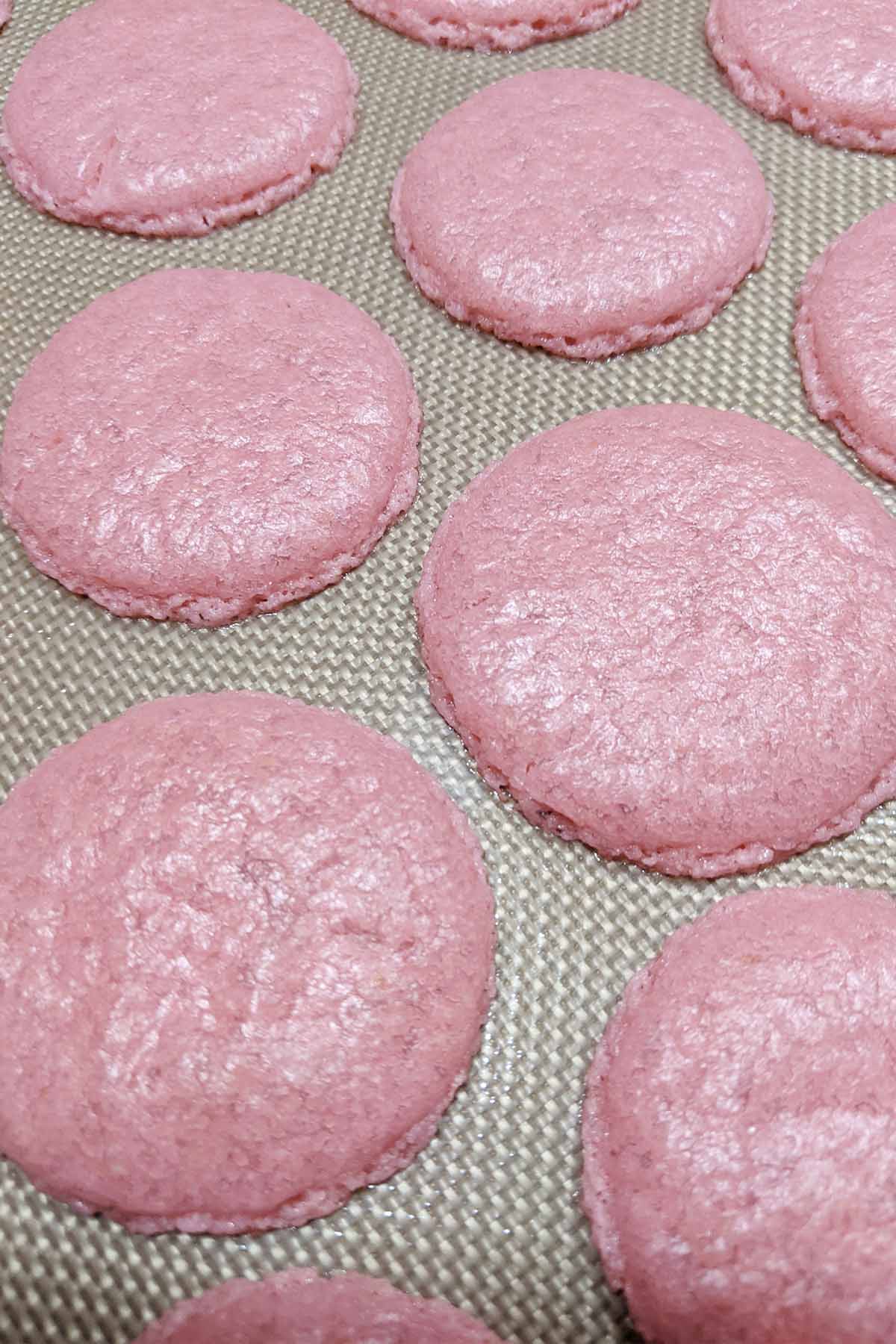














Leave a Reply